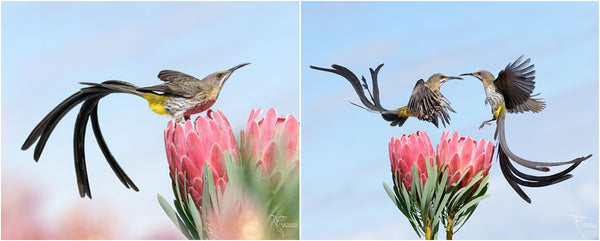
Next on the easel: A duelling duo
Share
I’m beyond excited about diving into my next super-realistic wildlife piece! I recently stumbled across Rozanne Fleet’s Instagram account, featuring a collection of the most amazing photos of Cape Sugarbirds captured in Franschhoek (@feathersoffranschhoek).
Cape Sugarbirds are undoubtedly friggen amazing - the males with their dramatically long tail feathers; their cute little yellow bums; their impressive, decurved bills; their hysterical, big-bird-trapped-in-a-little-bird’s-body-attitudes… Add to this the fact that they are specialist nectar feeders and are always found around proteas and pincushions and other equally spectacular fynbos flowers… Fabulous, right?!
But, the ability to actually capture all of this the way that Rozanne does, is a special gift. Practically every one of her photos takes my breath away! It is her talent to relay an enticing sense of movement that specifically compelled me to reach out to find out if she would allow me to paint one of her photos. After all, I’m working on a collection of artworks with the theme, “Move!”, for my 2025 wildlife calendar…
After ages of scrolling through her stunning collection, I finally decided on the photo that I’d like to use as reference, and thankfully Rozanne gave her blessing.
Unable to contain my excitement, I immediately started the process of figuring out the dimensions and crop of the painting. And that’s when I noticed a problem…
Allow me to digress for only a moment, and for a very important explanation:
Not all photos - no matter how good - make for successful paintings. Think of it like translating a really beautiful poem from one language to another. You have to make adjustments or replace words to maintain the rhyme. Sometimes the meaning gets lost in the process, or the poem just doesn’t carry the same… oomph! The same can be said of “translating” a photo into an artwork. With experience, I’ve learned to spot this before I commit to using a photo as reference. Sometimes a fantastic image won’t work, simply because of that shadow will suddenly look bizarre when painted; if I paint the animal’s head in that angle, it will look strangely squashed; or the way that this birds’ wing overlaps with the rest of its body is going to be a hot mess when painted.
And the latter was exactly what I noticed when I spent some time really taking in every detail of my chosen reference image, “translating” it into a painting in my head…
I was just about to get all whiny and pathetic, when I spotted another photo in Rozanne’s feed: A male bird with attitude-a-plenty, perched on the same gorgeous duo of proteas. In fact, it’s quite likely to be one of the same two birds from my favourite image!
Would Rozanne allow me to combine two of her images to paint from?
“You may do whatever you wish!”, she replied to my sheepish apologetic explanation. Yay!
So there you have it, folks! The next painting on my easel will be a combo of two sensational pictures of two sensational sugarbirds, duelling on/above a set of sensational proteas!
Wish me luck!


